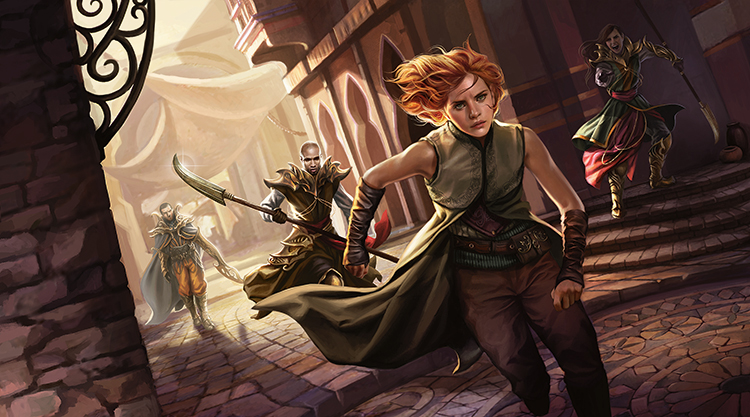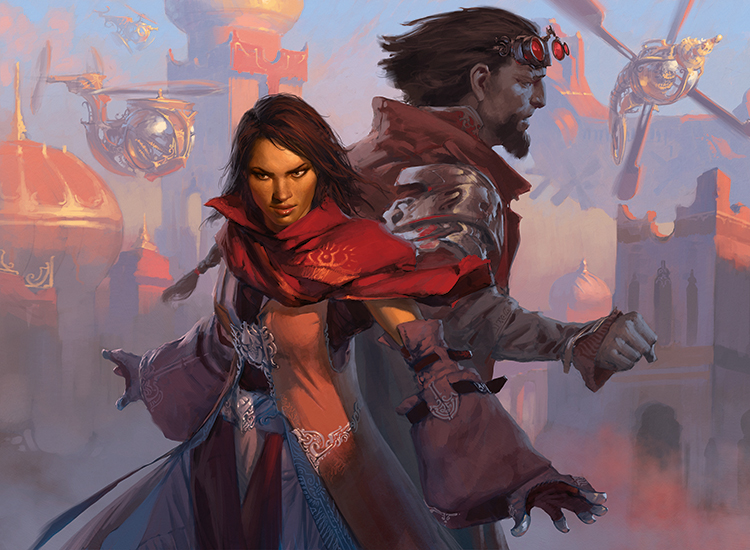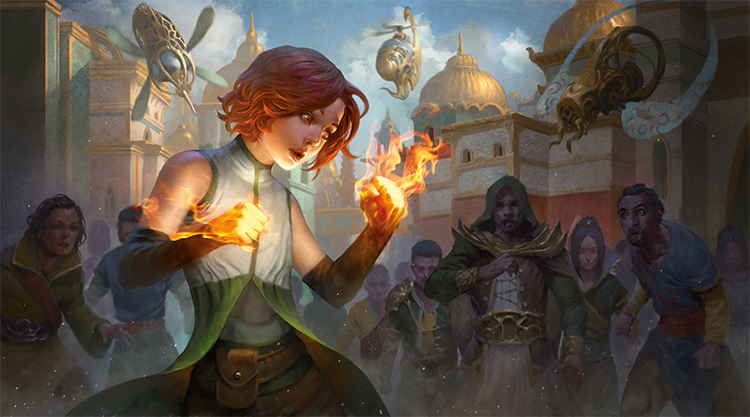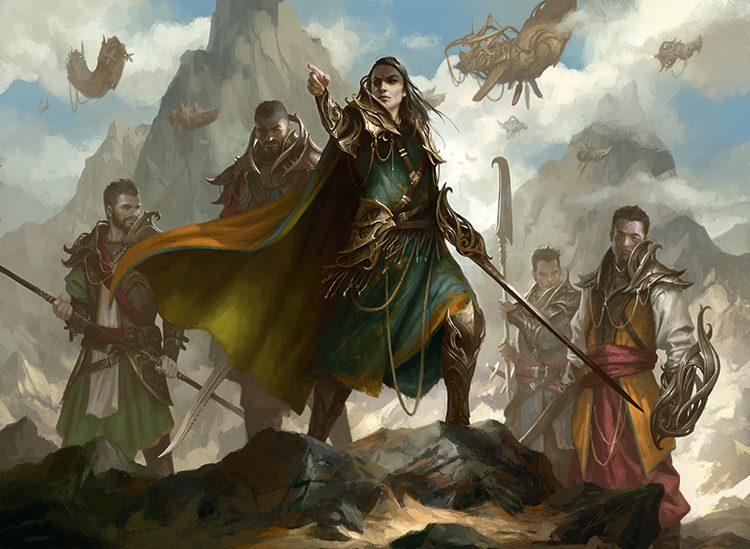Sometimes it feels like Wizards takes two steps forwards and one step back. Their efforts to improve the cultural diversity of Magic should be applauded, this is true. However, it is equally important to highlight when their actions miss the mark. Wizards is in a unique position to push the envelope on diversity for an entire genre, and when they pass up that opportunity because of “traditional” beliefs it can be infuriating. Today we’ll talk about how they completely dropped the ball with everyone’s favorite pyromaster.
Chandra, the Moon Goddess
There’s no beating around the bush here. Chandra ought to have been Magic’s first Indian planeswalker. This past week, Wizards unveiled the first of the five origin stories that will be featured in Magic: Origins. Chandra Nalaar was first up to the plate. Her story is that of a young rebellious girl who is the pride of her parents no matter what she achieves in life. Her pyromantic powers literally explode while she is evading pursuit by the authorities forcing her family to go into exile. Eventually the authorities track down the Nalaars, execute mother and father, and bring young Chandra back to the capital city to be publicly humiliated before her own execution. Chandra’s spark ignites while facing the executioner’s blade and she awakes on another world.
So let me ask you, why did this story have to be about a white girl when it so obviously could and should have been about an Indian girl?
Kaladesh, Ghirapur, and the Nalaars
The world of Chandra is a world of Indian culture. This much is painfully obvious from the names alone.
- Chandra – This is the name of the Hindi god of the moon.
- Kaladesh – The name of Chandra’s home world is also rooted in the Hindi language. Desh, as a suffix, means land or province or country, like Bangladesh or the state of Uttar Pradesh. Kala means art or arts (according to Google translate at least). So Kaladesh is the land of the arts, possibly referring to the culture of invention and creation.
- Ghirapur – Similar to ‘desh,’ we find ‘pur’ commonly used for the names of Indian cities such as Jaipur, Kanpur, and Nagpur. Ghir could be translated to clouded and Ghira could be translated to surrounded. It’s difficult to divine Wizards intent, but it is obvious enough that this is an Indian city.
- Kiran Nalaar and Captain Baral – These are clearly Indian names. Kiran is a very common name in India. One of my co-workers is named Kiran. Baral has its own Wikipedia entry for being one of the most common Nepalese surnames.
- The Akhara – Last but not least, this comes directly from Indian culture and you can read more on the Wikipedia entry.
So it’s clear that the creative team did their homework when it came to the creation of an Indian culture for the world of Kaladesh which would serve as the birthplace of Chandra Nalaar. This is great news! Improving the cultural diversity of the game is a major stepping stone to growing the game internationally and also helping to improve the culture of the community as well.
So why is everyone so damn white?

Not Shown: The abundance of non-white people who supposedly live in this city.
Doug Beyer Explains
This very question was raised to creative team member Doug Beyer on his Tumblr and he kindly replied:
I think you’ll see soon, once Magic Origins previews begin in earnest (starting June 22), that Kaladesh is a diverse plane with many ethnicities – including, prominently, many humans who look Indian. Chandra has been repeatedly illustrated as a light-skinned person with red hair, and we didn’t try to change that about her when showing her childhood. But many of the illustrations published with Chandra’s origin story focus on light-skinned Chandra, so I get that Kaladesh probably looks whiter than we intend from what you’ve seen so far. Valid. Give us a couple weeks for more previews and more art to be revealed?
There are two points I want to look at here, one of which I think Doug is missing and one of which I think Doug is completely wrong about. Firstly, the issue is not only with depictions of Chandra but also the depictions of the other characters in this story.

The story implies that this is the depiction of mama and papa Nalaar. Now, I’m not a genetics expert, and I do understand that red hair is a recessive trait that can be passed on and skip generations, but honestly, I have a lot of trouble buying the idea that these two darker-skinned inventors procreated to produce the most Irish looking child the world had ever seen.

Look at the crowd of people surrounding poor young Chandra. Other than the man in blue on the far-right side, this is a group of white spectators observing the painfully pale white main focus of the artwork. The architecture is part-Indian/part-Russian and the steampunk elements are here as well, but the people are mostly white. It feels more like Russia or Venice with some Indian architectural elements than India, which is where all the names come from.

This is Captain Baral and the soldiers who are pursing the Nalaar family. Even though we already established that Baral is an incredibly common Nepalese surname, Captain Baral has incredibly pasty white skin. His compatriots, who are soldiers, are also virtually all white. The guy in the shadow behind Baral might be dark-skinned and the guys on the right might be southeast Asian, but with Baral looking very much Caucasian as the focus of this art, it really detracts from the possible ethnicity of the soldiers with him.
Some Half-Baked Explanations
I truly feel that Doug Beyer is missing the point. It isn’t just that Chandra is white. It’s that literally everyone else in the artwork here, and especially the major characters, is creating a huge disconnect. The culture is clearly Indian. The names of places are Indian. The names of people are Indian. Why does everyone look Caucasian? Beyer says that as more artwork for Kaladesh is released we’ll see more of the true intention, but how much more could there really be? With ten planes to chose from, how many cards will really focus on Kaladesh? Maybe 20?
What About Chandra?
Let’s get to the most important point. Chandra should be Indian. Literally the only reasons to maintain that Chandra is pale-skinned instead of Indian would be either a) they are so attached to branding and marketing to white people that they fear the backlash from the enfranchised bigots they cater today isn’t worth opening their market to one of the world’s largest populated countries or b) they’ve already set their hearts out on casting Felicia Day or Karen Gillan as Chandra in the Magic the Gathering Movie.
Both of those explanations suck. India is a massive market and diversifying the game with Indian culture would be a huge win for Wizards. Instead, they are falling back on the tried and true marketing and branding practices that have created a culture where we can only put white people in movies, all boys toys are blue, all girls toys are pink, and various other cultural and gender problems abound. Hasbro, of course, as the parent company of Wizards is possibly part of this problem, as they continue to perpetuate many of these stereotypes.
Wizards could have simply decided that enough was enough, they had made a mistake in depicting Chandra as white, and they were going to fix it going forwards by depicting her as Indian. People would have been sad, for sure, but really for no good reason. The explanation of why Chandra in Lorwyn is white and Chandra in Origins is brown would be “because Wizards made a mistake and finally decided to fix it.”
End of story.
Magic has enough white female planeswalkers with Liliana, Nissa, and Elspeth all filling the role. Sure, Kiora is blue, but not really reflective of an actual human culture. Why shouldn’t Chandra be Indian? Feel free to give me your incorrect answers to that question in the comments below!
The Quick Hits
- Derrick Heard brings up the age-old topic of legalizing gold-bordered cards for tournament play. I think it’s interesting people keep bringing this up when a) it’s never going to happen and b) Wizards has repeatedly confirmed that it’s never going to happen. Save your breath Derrick [Legit MTG]
- Apparently Chas Andres, the financial guru and satire expert for Star City Games is writing a weekly column for Daily MTG which is about flavor. Let’s just hope he leaves the satire to The Meadery [Daily MTG]
- MJ Scott brings the Noble Hierarch cosplay and James Arnold brings the Rafiq fan fiction. The Vorthos in you will be doubly satisfied [Gathering Magic]
- Mike Linnemann talks about the changing landscape of acquiring original Magic art direct from the artists including the challenges presented by the rising costs of original compositions and prints [Gathering Magic]
- Danny West talks about fate, luck, life, and Magic the Gathering [Star City Games]
- Hall of Fame player Raphael Levy discusses the idea of whether or not Magic should be considered a sport [TCG Player]
- Check out this amazing infographic compiling stats from Modern Masters Weekend [Quiet Speculation]
- Henry Druschel breaks down the MTGO economy and why the price of packs is tanking [Channel Fireball]
- You can now pre-order Arena of the Planeswalkers, the upcoming Magic board game [Cool Stuff]
- The SDCC promos for Jace, Nissa, and Chandra have been spoiled. Click at your own peril [Gathering Magic]
Wallpaper of the Week

I really love the scenery in this painting. It helps to show the diverse cultures of Kaladesh as a mix of Indian and Mediterranean architecture and colors with a steampunk atmosphere. It’s very likely the style guide for the city of Ghirapur was to present a Venice-style city with Indian architecture and Russian colors but also through in some airships. I’m definitely looking forward to Curtis having some time to talk about all the different elements in Ghirapur. Unfortunately, if you read the entire article you’ll understand that this wallpaper is getting knocked down a bit for continued depictions of Chandra as Caucasian.
Grade: C+
What We Learned is a weekly feature here at Hipsters of the Coast written by former amateur Magic Player Rich Stein, who came really close to making day two of a Grand Prix on several occasions. Each week we will take a look at the past seven days of major events, big news items, and community happenings so that you can keep up-to-date on all the latest and greatest Magic: the Gathering community news.

